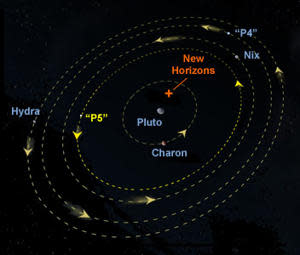 Science and Weather
Science and WeatherPluto may have 10 more undiscovered moons! Wow!

Okay, we just got finished marveling at the fact that Pluto, as small as it is, has five moons orbiting it, and we just finished picking names for the two latest finds, but now a new study has shown that it may have 10 more, bringing its total up to 15 moons!
That's more than we've seen orbiting the gas-giant Neptune!
Although it hasn't been confirmed yet, this possibility arose from a study of how the moons that we do know about formed around the tiny dwarf planet.
[ More Geekquinox: Contest seeks public name for closest exoplanet ]
Astronomers know that Pluto had a dust cloud that formed a long time ago. They're not sure exactly how it happened, but it either came from an impact with Charon (Pluto's largest moon/possible binary-planet companion), or it swept up the matter in the cloud from the remnants of the protoplanetary disk that our solar system formed from, or maybe a bit of both.
To see how Pluto's known moons formed, a pair of scientists — Scott Keyton from the Harvard-Smithsonian Center for Astrophysics and Benjamin Bromley from the University of Utah's Department of Physics — designed a computer simulation that would track the dust in the cloud as it collided and clumped together and eventually formed P4 (Vulcan?), Nix, P5 (Cerebus?) and Hydra.
The simulation worked, but it didn't just generated the orbits of the four moons we know about, it also generated several more, suggesting that there could be anywhere between one and 10 additional moons orbiting beyond Hydra, each between 1 to 3 kilometres in diameter.
The unfortunate part of this is that there's no way we can verify this from Earth.
"Pluto is so bright," said Kenyon, referring to how the glare from Pluto would 'wash-out' the light from any smaller moons. "I don’t think a ground-based telescope would have a chance, and it’s at the limit of what [Hubble Space Telescope] can do."
[ More Geekquinox: Has Voyager 1 actually reached interstellar space? ]
Our best chance will come from NASA's New Horizons mission, which is due to make a close-pass by Pluto and its moons in July of 2015.
The research paper, titled The Formation of Pluto’s Low Mass Satellites, is available on arXiv.org.
Geek out with the latest in science and weather.
Follow @ygeekquinox on Twitter!



